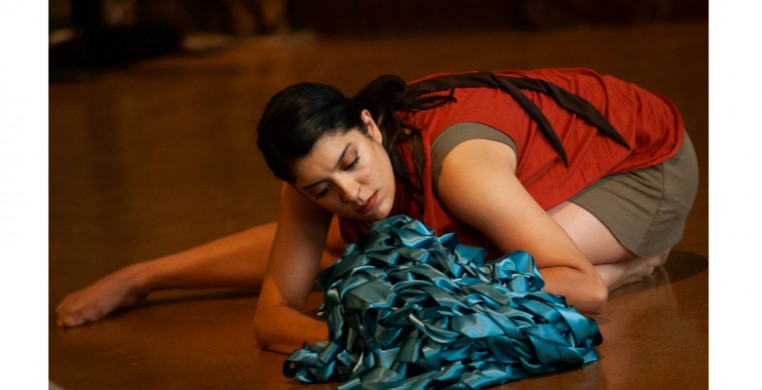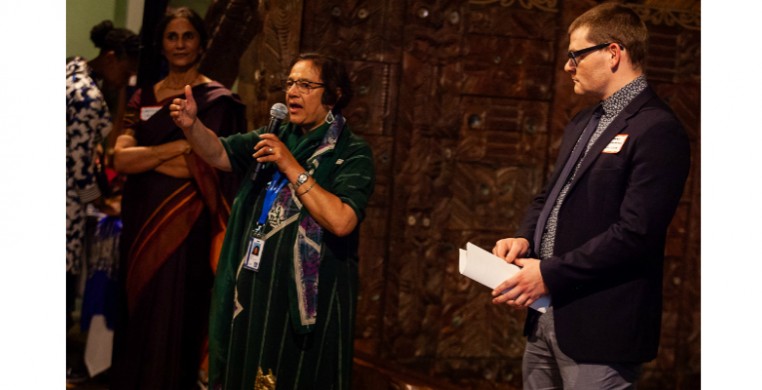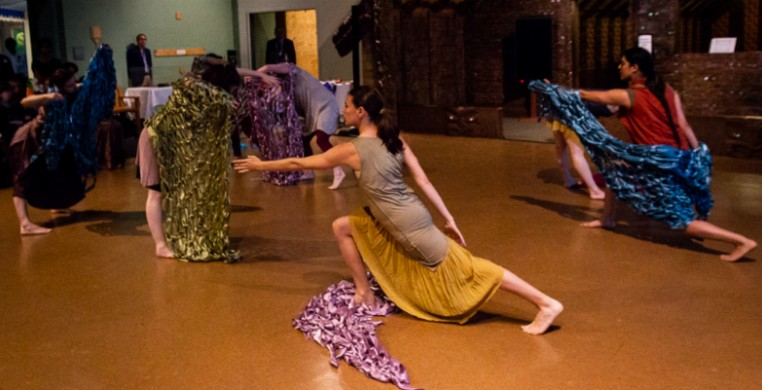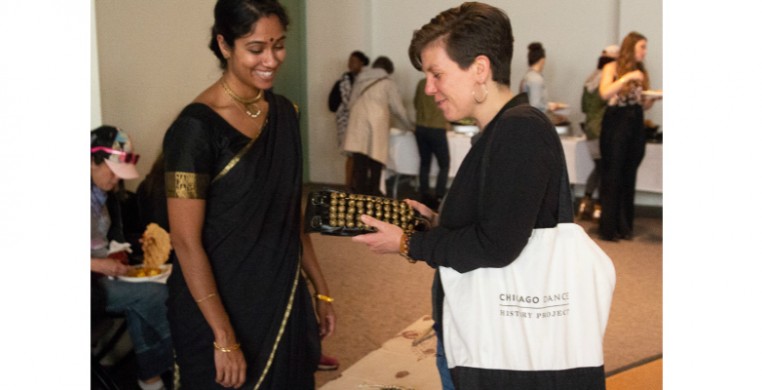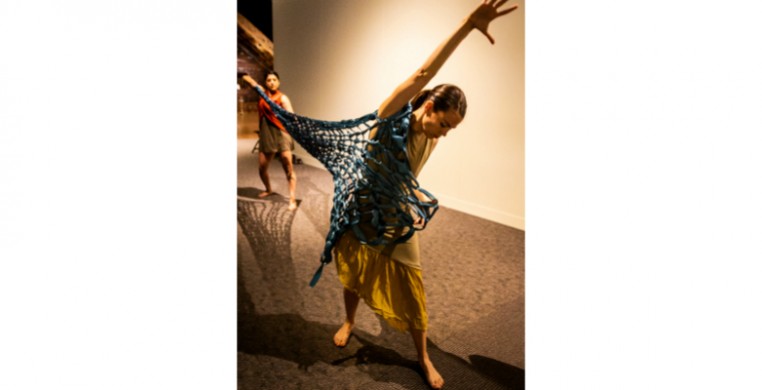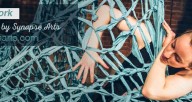"Moving Dialogs: Culture in Motion," a joint effort between See Chicago Dance and the Chicago Cultural Alliance, paired three dance companies with three of Chicago’s cultural heritage centers to exchange ideas. Each team, in its own way, used culturally-specific artifacts from the museum’s collection as fodder for generating choreography from a group of dancers largely unfamiliar with the traditions of that culture.
The series kicked off April 3 at the Buddhist Temple of Chicago, with Chicago Dance Crash’s Portia Spells and representatives from the Haitian-American Museum of Chicago joining forced to translate aspects of Haitian Rara celebrations and themes from work by artists such as Jean Yves Hector and Gerard Valcin into a polished piece of choreography (which the audience was then invited to dismantle).
On May 9, guests gathered at the Chinese-American Museum of Chicago for Valerie Alpert Dance Company’s interpretation of artifacts specifically related to the experience of Chinese immigrants to the United States. Identity loomed large as the discussion shifted between the role of the Chinese hand-laundry in providing one of the only sources of work among Chinese immigrants, to the “paper sons” who gained entrance to the U.S. by memorizing false family histories and presenting forged documents, to the fascination of mah jongg – a traditional game involving tiles labelled with Chinese characters – among affluent Jewish women.
The final Moving Dialogs on June 5 – a collaboration between the The Indo-American Heritage Museum (IAHM) and Synapse Arts – brought us not to the museum’s Indo-American Center in the Devon Avenue Desi Corridor, but to the heart of museum campus. After winding our way through the bowels of the Field Museum after hours, guests meandered through the Regenstein Halls of the Pacific on the museum’s second floor to find two dancers weaving enormous satin thread with their hands at the very back of the gallery. Hang a left, and one was treated to various finger foods inspired by Indian cuisine, and an open bar. The food and libations stop was part of a circle of stations to peruse as we noshed during the casual portion of the evening. At each station was a table of artifacts related to India and Indian-American culture, whose owners were on hand to tell stories about their belongings.
IAHM’s mission is to “preserve the history of the Indian-American community and celebrate [their] culture and contributions to promote understanding,” as Padma Rangaswamy, president of the board of trustees for the museum, stated.
Raja Nadimpalli spoke of a treasured song book, from which she would later sing as an accompaniment to Synapse's dance, while Bharatanatyam dancer Vidya Govind presented the bells and rhythm stick of her mentor and dance teacher Hema Rajagopalan, who is the founder and artistic director of Chicago’s oldest Indian dance company, Natya Dance Theatre.
Alaka Wali, a representative from the Field Museum who is originally from India, spoke about jewelry, textiles and wooden stamps from the museum’s Anthropology Collections which are used to create embellishments and patterns on fabrics to be used for garments such as saris. A “touch station” brought us closer to these items, and included IAHM’s Lakshmi Menon describing the aesthetic differences between fabrics generally seen in different regions of India.
The most significant item ended up being Happie Datt’s yogurt bowl, a simple household item which brought Synapse director Rachel Damon to tears as she described Datt’s beautiful story about how the process of making yogurt from scratch connected her to generations of women.
These are not pieces of fine art, but personal items whose value is more sentimental than financial. They are products of normal, everyday life that, through their use, hold great significance. It reminded me of Rachel Maddow’s interview with the New Yorker, in which she said her singular regret thus far as the host of MSNBC’s The Rachel Maddow Show was criticizing a set of homely brown canisters on the air. The move incited a surprising backlash of reactions, most of them related to passed down sets similar canisters in kitchens across the country. I admit, I have a similar attachment to my mother’s amazing avocado-hued glass canisters that hold a prominent place in my kitchen.
Completing the circle of artifact stations, at the back of the room, sits the Field’s Maori meeting house – imposing and inviting – an anchoring structure in this gathering space and the backdrop for Synapse’s performance of sections from their evening-length concert called “Light Hand.”
My experience here was specifically colored by two recent performances which travelled through mansion homes in the Edgewater neighborhood. In the first, performance artist Corey Smith led guests through the 1909 Colvin House, an American Foursquare recently returned to grandeur after falling into disrepair. During the performance, Smith gave a mishmash of ideas to consider: The property, a product of the Prairie School of Architecture and one of few remaining single-family homes on this stretch of Sheridan road, was built by Chicago elites in an area of the city initially developed as a summer resort town. Many of these homes have been swallowed by lakefront high rises – all of it sitting on land once occupied by Native Americans from the Potawatomi, Miami and Illinois nations.
Across the street in Berger Park, the full version of Synpase’s “Light Hand” traveled through the Gunder House, another American Foursquare completed the following year, now owned by the Chicago Park District. The rich tones of the mansion’s interior woodwork parallel those on the front of the Maori meeting house, a structure built by indigenous people from Tokomaru Bay, New Zealand, in 1881. The structure invokes the spirit of Ruatepupuke, an ancestral woodcarver, and was sold to the museum in 1905. It remains the only such meeting house in the country, and the Field worked with descendants of the community from Tokomaru Bay to establish its current place of prominence in the gallery.
The placement of a dance performance in front of this sacred meeting house drew some criticism, specifically from a patron watching a livestream of the performance on Facebook. Wali spoke of its significance, how it came to be part of the Field’s collection, and how the belief that the spirits of Maori ancestors are present within the house deem it critical that the structure is still used as a gathering place.
As a kick-off to the more formal presentation of the evening, in which Synapse Arts presented bits and pieces – some new, some revisited – of Damon’s “Light Hand,” a long-term investigation combining textiles with dance, Menon lit an oil lamp in front of the meeting house, explaining the significance of light in Indian Culture.
“It is really common to start an event or program by lighting the lamp,” she said. “The symbolism of light is universal across all the cultures of the world, across all the faiths in the world. In our case, it springs from a Hindu tradition of illuminating the darkness. … I think when you stop and look at the flame, it settles the mind, and centers you into what is about to start. And so, it is in that spirit today that we start with the lighting of the lamp.”
Following Synapse’s performance, the audience had opportunities to manipulate the choreography and play with the order of its elements, change the props or the music, or suggest an aesthetic shift such as altering the tempo or mood of the movement. In this last installment of “Moving Dialogs,” the movement Synapse presented didn’t appear particularly affected by Damon’s interactions with the collection – that is, this pairing of textile dances and Indian artifacts fit together more naturally than the other combinations. But a profound transformation occurred by the end of the evening, which included a retelling of Datt’s story about her mother’s yogurt bowl as Synapse’s contemporary dancers moved with a combination of saris and their silken textiles and Govind joined to interpret the tale through classical Indian mudras.
In so far as the IAHM – and more broadly the Moving Dialogs series as a whole – seeks to promote cultural understanding, this cogent blending of artistic practices incorporating symbols and traditions from India, Europe and New Zealand feels wholly American. The willingness of series participants to openly ask questions, challenge assumptions, and speak to the unique experience of immigrants to the United States feels critical in a moment in which many overtly cling to identity as a means to divide, rather than unite us.
Lauren Warnecke is the dance writer and critic for the Chicago Tribune.

